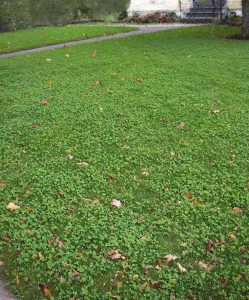There are many benefits to having clover in lawns:
– Combined with mulch-mowing, the clover can supply most or all of the turf’s needs for nitrogen. Clover and other legumes are infected by soil bacteria which form nitrogen-fixing nodules on the roots. Nitrogen fixation can contribute the equivalent of 2 lbs of nitrogen per 1000 square feet annually (1 kg N/100m2 ). .
– Providing nitrogen inputs via legumes and recycling of residues (grass clippings) reduces leaching of all nutrients; requirements for lime may be reduced by 75% or more.
– Grass/clover turfs maintain greenness through mid-summer droughty periods when straight bluegrass turfs go into dormancy unless well watered..
– Clover competes effectively with other broadleaf plants, reducing the amount of manual-weeding that might be practiced otherwise.
– An appropriately managed grass/clover turf forms an aesthetically pleasing sward which masks the presence of many types of weeds, i.e., the weeds blend into the sward, rather than stand out.
– Clover is reported not to scald, as grass does, when dogs urinate on it.
– A mixed grass/clover sward tends to be more resistant to pests and diseases than is a straight grass sward.
– A mixed grass/clover/small-leafed-flowering-dicot sward increases biodiversity, especially by supporting pollinating insects.!
It’s pretty easy to overseed a lawn with clover, but it is best done in the spring before grass starts to grow vigorously. Early April is ideal, but anytime from late March through to about May 5 should work in HRM.
For more about overseeding with clover, view Establishing White Clover in Lawns, also an earlier post on this website.

